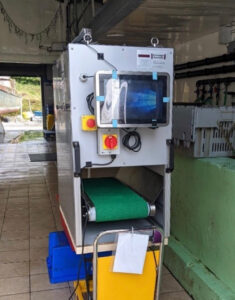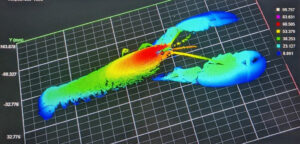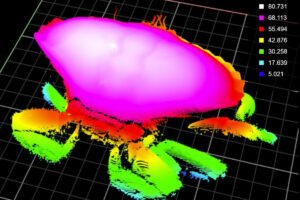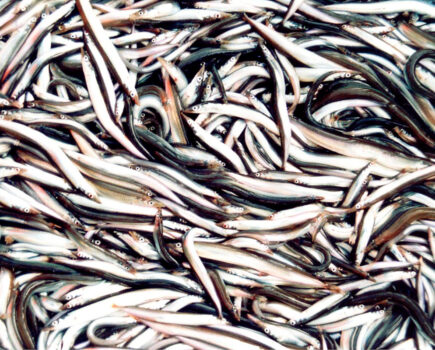With the UK Seafood Innovation Fund’s latest research and development projects underway, Fishing News is delving into some of the innovations that the fund has supported. This week: a new technology to transform what we know about landed crustaceans for stock assessments
Globally, it is likely that many commercially fished crustacean stocks are data deficient, which means that we do not have enough information about the age structure and sex ratio of these populations to know if they are being fished at sustainable levels.
The cost and time needed to undertake both fisheries-dependent and fisheries-independent stock assessment are a significant barrier. The process of collecting data for stock assessments usually involves manually measuring and sexing relatively large numbers of animals at sea, and in markets and processing facilities.
As part of the EMFF Scottish Fisheries Integrated Data System project, a team at the University of St Andrews and Seascope Ltd developed a prototype which was capable of producing rapid 3D scans of European lobsters and brown crabs, the idea being to try to develop a way of automatically taking the measurements needed for stock assessment. The prototype was sufficiently promising to secure further funding from the UK Seafood Innovation Fund (SIF).

The EU EveryFish project is now working to redesign the current AS3ID to produce the CATCHS3ID, which will be compact enough to be carried onboard a potting vessel.
The team at St Andrews, working with Envision Systems Ltd, further developed this into a robust device to test in the field.
The Automated Species, Sex and Size Identification Device, or AS3ID, was used to scan hundreds of lobsters and crabs at Murray McBay & Co in Johnshaven and at Barra Atlantic in the Western Isles. After scanning, each animal was manually measured to provide a way of confirming if the scans can be used to produce the correct measurements.
Initial research showed that it is possible to determine the sex of adult lobsters and crabs by comparing the ratios of key measurements, and without having to identify the related anatomical structures on the underside that are normally used to determine sex. This means it is feasible to feed lobsters and crabs right-side-up through the device on a conveyor belt and still determine their sex.
The 3D scans should be sufficiently accurate to train an artificial intelligence (AI) network to recognise the species and use the measurements it derives to determine sex and provide the measurements needed to feed into stock assessment models. The process of developing the AI was partially completed by the end of the SIF project.
Following this, the St Andrews team were invited to become part of the EU EveryFish project, which runs from 2022 to 2025. The objective is to redesign the current AS3ID to produce the CATCHS3ID – a device which will be significantly lighter and smaller. This will allow the device to be portable and useable on the deck of potting vessels of 10m and over, as well as in market or processing facilities.
Further work on the development of AI is also underway for lobsters, in particular where the back of eye socket to back of carapace measurement remains challenging.
Dr Mark James, who is leading the project to develop the scanning system, noted that the UK government’s Sentience Bill means that the St Andrews team needs to assess whether the scanning process, which involves a 3R laser, has any adverse impact on the eyes of the animals being scanned.

Work is underway to ensure that the laser scanning process causes no harm to the eyes of the crustaceans being passed through the machine.
Lasers in the 3R class would not normally harm human eyes during a momentary exposure of less than a quarter of a second. This is the time it takes for a person to turn away or blink to avoid bright light. But as lobsters and crabs have no blink response, it is important that any potential adverse effects are assessed before progressing the development of the system using these lasers. The results of this research will be known by the end of 2023.
The AI development for automated measurement will continue as it will be applicable to the analysis of 3D scans – even if these need to be acquired through a less powerful laser or other scanning technology.
The vision is to create a device that will allow stock assessment data to be collected as part of controlled surveys involving industry in the data collection process. In principle, the device is capable of measuring many thousands of crustaceans automatically on a daily basis. It also has the capacity to transmit the necessary measurement data, linked to GPS position via the mobile telephone network to a dedicated server and database.

he Automated Species, Sex and Size Identification Device (AS3ID) can produce rapid 3D scans of brown crabs and lobsters. From the ratios between key measurements, their sex can then be determined.
In the future, this could potentially lead to more automated data analysis and more frequently updated stock assessments at meaningful geographic scales to inform fisheries management.
The UK Seafood Innovation Fund (SIF) is part of the UK government’s £100m UK Seafood Fund. Through multiple calls since 2019, SIF has awarded a combined total of £17m to 116 feasibility or research and development projects across fisheries, aquaculture, processing and the supply chain. Its aim is to boost the resilience and sustainability of the UK seafood sector by supporting a diverse range of innovative and scalable ideas.
SIF is administered by the Centre for Environment, Fisheries and Aquaculture Science (Cefas) on behalf of the Department for Environment, Food and Rural Affairs (Defra).
For more information, go click here.

This story was taken from the latest issue of Fishing News. For more up-to-date and in-depth reports on the UK and Irish commercial fishing sector, subscribe to Fishing News here or buy the latest single issue for just £3.50 here.
Sign up to Fishing News’ FREE e-newsletter here.








